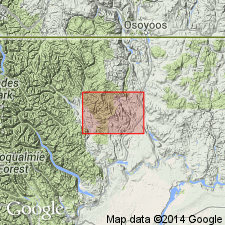
- Usage in publication:
-
- Salmon Creek Schists and Gneisses
- Modifications:
-
- Named
- Dominant lithology:
-
- Schist
- Amphibolite
- Gneiss
- AAPG geologic province:
-
- Okanogan province
Summary:
Unit is named for locally migmatized, metamorphosed rocks cropping out along Salmon Creek. Type area designated on northeast slope of Ruby Hill where Salmon Creek has deeply incised its canyon, Okanogan Range, north-central WA. Divided into two groups: (1) isochemically metamorphosed amphibolitic schists and amphibolites; calcareous, quartzitic, pelitic, and quartzo-feldspathic rocks; and (2) allochemical group of migmatitic, layered, augen and flaser; and more homogeneous gneisses. Is in part equivalent to metamorphic complex of Conconully of Rinehart and Fox (1976) which is at least partly of Late Triassic age. Owing to complexity of stratigraphy, Salmon Creek Schists and Gneisses are considered to have been metamorphosed sometime between the Norian and 129 +/-2 Ma (Late Triassic to Early Cretaceous). Shown on sketch map of central Okanogan Range, WA, as of pre-Jurassic age.
Source: GNU records (USGS DDS-6; Menlo GNULEX).
For more information, please contact Nancy Stamm, Geologic Names Committee Secretary.
Asterisk (*) indicates published by U.S. Geological Survey authors.
"No current usage" (†) implies that a name has been abandoned or has fallen into disuse. Former usage and, if known, replacement name given in parentheses ( ).
Slash (/) indicates name conflicts with nomenclatural guidelines (CSN, 1933; ACSN, 1961, 1970; NACSN, 1983, 2005, 2021). May be explained within brackets ([ ]).

